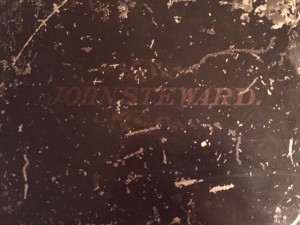 My grandfather died almost 25 years ago, and sometime before that he gave me a box of “family papers.” The box itself is rather striking: a metal strong box, easily portable, with my great-great-grandfather John Steward’s name stenciled on top in fading paint. Inside the box are not just family papers, but intriguing (and, of course, unidentified) daguerreotypes and examples of other early photographic processes, along with materials treating the family of my great-grandmother, Margaret Atherton (Beeckman) Steward (1861–1951). Continue reading Family papers
My grandfather died almost 25 years ago, and sometime before that he gave me a box of “family papers.” The box itself is rather striking: a metal strong box, easily portable, with my great-great-grandfather John Steward’s name stenciled on top in fading paint. Inside the box are not just family papers, but intriguing (and, of course, unidentified) daguerreotypes and examples of other early photographic processes, along with materials treating the family of my great-grandmother, Margaret Atherton (Beeckman) Steward (1861–1951). Continue reading Family papers
All posts by Scott C. Steward
A great spectacle
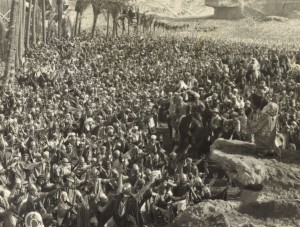
Ben-Hur: A Tale of the Christ (1925) was one of the great spectacles of the silent period; it was also one of the first movies to be produced by the newly amalgamated Metro–Goldwyn–Mayer film corporation. The uncredited cast list reads like a Hollywood Who’s Who of the 1920s (and later): among the (future) stars said to have participated in the film are John and Lionel Barrymore, Gary Cooper, Joan Crawford, Marion Davies, Douglas Fairbanks (Sr.), Clark Gable, Janet Gaynor, John Gilbert, Dorothy and Lillian Gish, Harold Lloyd, Carole Lombard, Myrna Loy, Colleen Moore, Mary Pickford, Sally Rand, and Fay Wray.[1] Continue reading A great spectacle
The wider circle
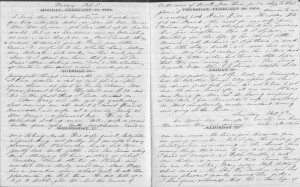
A frequent refrain here at Vita Brevis is that genealogists should consider not just their direct ancestral lines, with a glance at collaterals like siblings or close cousins, but the larger community in which a forebear or collateral relative lived. I was struck by this dictum as I reviewed the Regina Shober Gray diary this winter, as Mrs. Gray lived in a time and place which Jane Austen would have recognized: even the diarist’s closest friends were generally referred to by their married names. Continue reading The wider circle
“Daylight upon magic”
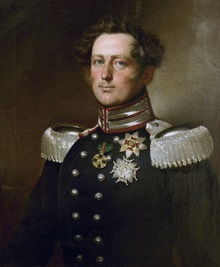
The British constitutional historian Walter Bagehot (1826–1877) wrote that “When there is a select committee on the Queen, the charm of royalty will be gone. Its mystery is its life. We must not let in daylight upon magic.”[1] There is something uncanny about royalty, a mystique that can be hard to value according to its merits. This phrase of Bagehot’s – with its reference to “mystery” and “magic” – came to mind as I was thinking about the question of morganatic marriages in Germany. Continue reading “Daylight upon magic”
“Mr. Loring’s play”
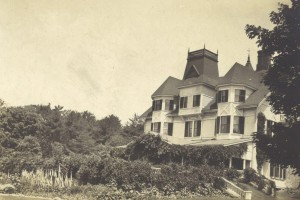
My cousin Neil recently shared some family albums with me: the oldest one belonged to his grandfather, Frederick Ayer (Jr.) (1888–1969), who kept it in 1905 and 1906. Over time, the images and the captions have faded, and the book’s middle section is held together with ancient cellophane tape, but Uncle Fred obviously cared about the record he was keeping. One of the most puzzling, and therefore interesting, images fills almost an entire leaf of the album; the identifying captions are squeezed out to the page edge: D. Sohier, D. Beal, F. Ayer Jr., etc. Continue reading “Mr. Loring’s play”
400 posts at Vita Brevis

Friday’s post, by Steven Solomon of the Society’s Development team, marked the four hundredth blog post at Vita Brevis. Since its launch in January 2014, the blog has featured posts by 64 bloggers, almost all of them NEHGS staff members, with a few outside contributors or transcribed interviews making up the remainder. What does the genealogical mosaic about which I wrote in the first post at Vita Brevis look like after eighteen months in the blog’s life? Continue reading 400 posts at Vita Brevis
A slice of life

For as long as I’ve had my present office on the Society’s third floor, I’ve looked through my open door at a portrait of George Bruce Upton (1804–1874), the Society’s vice president between 1866 and 1874. I will confess that my eye did not linger over Mr. Upton’s portrait, as the representation does not appeal to me; on the other hand, immersed as I was this winter in my sabbatical project, once I noticed his nameplate I realized that Mr. Upton and his family appear frequently in the Gray diary:[1] Continue reading A slice of life
Not quite right
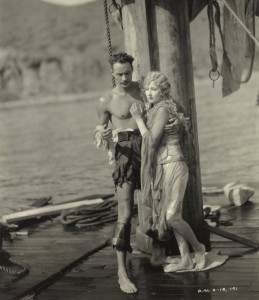
I recently bid on a photograph associated with a 1938 Cecil B. DeMille film called The Buccaneer, and noticed that the seller identified the man in the picture – the actor Fredric March (1897–1975) – but not the woman: a search at The Internet Movie Database (IMDb) suggested that she was the Hungarian actress Franciska Gaal (1904–1973). In the end, I won the auction, and when I went to pay the seller I started thinking about Miss Gaal’s hair – which led me on an internet search that revealed that the actress, the actor, and the film were not quite what they seemed. Continue reading Not quite right
State of the art
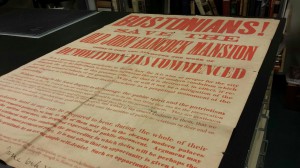
[Editor’s Note: As part of the Society’s commitment to serving as a repository of original documents, preserving (and, when necessary, conserving) them for future generations in all their forms, NEHGS has a state of the art document conservation laboratory about which both Jean Maguire and Deborah Rossi have written for the blog.]
From Conserving an historic family tree by Deborah Rossi:
“NEHGS is always looking to acquire family trees to add to our collection. They come to us through donation or purchase, and their condition on arrival varies from pristine and framed to dirty and frayed. Many a family tree crosses the threshold of the Society’s new Conservation Lab, where it is cleaned and repaired, resulting in a piece which can be safely stored or displayed. Continue reading State of the art
The scope of the Gray diary

For the last six months or so, I have been engrossed in the daily diary of Hedwiga Regina (Shober) Gray (1818–1885), a Philadelphia-born Boston lady who wrote about her family, her household, and the larger world between 1860 and 1884. In almost a dozen blog posts I’ve quoted Mrs. Gray on contemporary celebrities (Mrs. Jack Gardner’s behavior merits a scolding for being “fast”; the diarist’s children see Tom Thumb perform and are “much pleased & amused”); on the danger of fire in the household (Mrs. Henry Wadsworth Longfellow is burned to death, while Eliza Winthrop survives a mattress fire); and on the painful grief associated with settling a beloved sister’s estate as relationships degrade between Mrs. Gray, her surviving sisters, and their younger brother. Continue reading The scope of the Gray diary